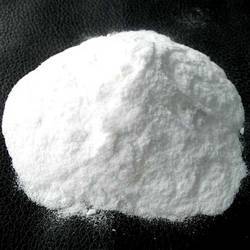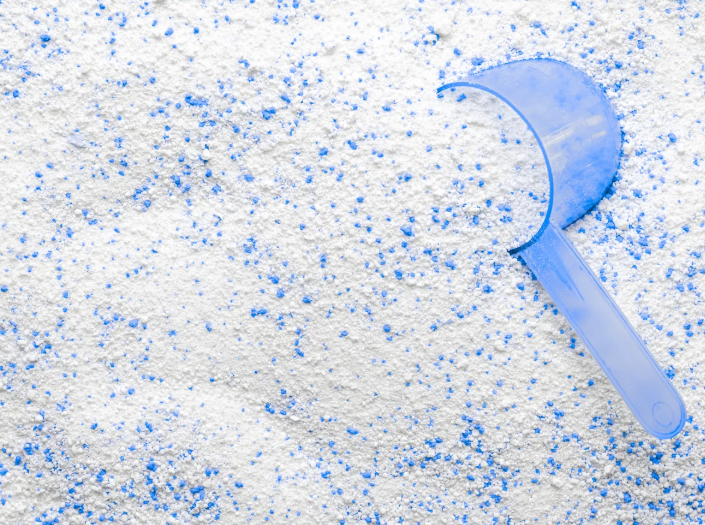Sodium bicarbonate (NaHCO₃), commonly known as baking soda, extends far beyond its roles as a kitchen essential or refrigerator deodorizer. In laundry detergent chemistry, it serves as a versatile and critical component, enhancing cleaning efficacy, fabric care, and formulation stability. Its unique properties deliver significant value across both conventional and eco-friendly detergent formulations.

1. pH Regulation and Buffering: The Foundation of Cleaning
The Alkaline Advantage
Laundry detergents function optimally within a slightly alkaline environment (pH 8-10.5). This alkalinity saponifies greases and oils (converting them to soap), breaks down protein-based stains (e.g., blood or sweat), and boosts surfactant and builder efficacy.
Bicarbonate’s Role
Baking soda serves as both a mild alkali and a potent buffer. It readily dissolves in wash water, elevating pH to the ideal cleaning range. Crucially, its buffering capacity maintains consistent alkalinity throughout the wash cycle—even when acidic soils dissolve—thereby maximizing the performance of other detergent ingredients.
2. Gentle Abrasion and Stain Removal
Mechanical Action
In its solid form within powdered detergents, bicarbonate of soda particles act as a very mild abrasive. This gentle abrasion helps remove particulate soils like dried mud or clay from fabric fibers without causing significant damage—especially important for delicate fabrics, unlike harsher abrasives.
Stain Lifting
Its mild alkalinity aids in loosening, lifting, and removing certain types of stains, particularly acidic ones (like fruit juices or coffee) and organic odors. It can help break down the matrix holding the stain to the fabric.
3. Water Softening and Builder Support
Calcium and Magnesium Precipitation
Though less potent than dedicated builders like zeolites or phosphates (where permitted), sodium hydrogen carbonate (baking soda) does exhibit water-softening capabilities. It reacts with calcium and magnesium ions in hard water, forming insoluble carbonates (CaCO₃, MgCO₃) that precipitate out. This precipitation prevents these hardness ions from interfering with surfactants and forming insoluble scum deposits on fabrics or inside the washing machine.
Synergy
It often works alongside primary builders, enhancing their overall effectiveness. This synergy can allow for reduced levels of stronger builders—which are sometimes more expensive or environmentally problematic.
4. Deodorization: Neutralizing Unpleasant Odors
Chemical Neutralization
Bicarbonate of soda is known for its ability to neutralize acidic odor molecules. In laundry, this translates to effectively combating common malodors like sweat, mildew, vomit, and urine. It doesn’t just mask smells; it chemically reacts with volatile acidic compounds, converting these acidic compounds into neutral or less volatile salts.
Adsorption
Its particles can also physically adsorb some volatile odor compounds, further contributing to odor reduction.
5. Enhancing Enzyme Performance
Stability and Activity: Many modern detergents rely heavily on enzymes to break down specific stains. Sodium hydrogen carbonate helps maintain an optimal, slightly alkaline pH environment in which many of these enzymes exhibit peak stability and activity, maximizing their stain-removing efficacy.
6. Chlorine Neutralization
Protecting Fabrics, Dyes, and Colors: In regions or formulations where hypochlorite bleach (chlorine bleach) is used, sodium bicarb can help neutralize residual chlorine. It helps prevent excessive chlorine damage to fabrics and dyes. This is especially beneficial in lower temperature washes, where chlorine can be more reactive.
7. Processing Aid and Bulking Agent
Powder Flow Improvement
In powdered detergent manufacturing, bicarb soda acts as a processing aid, improving the powder flow characteristics of the mix and helping to prevent caking during storage and handling.

Cost-Effective Bulking
Its relatively low cost makes it a practical bulking agent (filler), helping manufacturers achieve the desired product volume and density. Crucially, it performs this bulking role without significantly compromising detergent performance—especially valuable because it simultaneously provides functional benefits.
8.Advantages Driving Its Use
Safety
Generally Recognized As Safe (GRAS), non-toxic, non-irritating to skin (at typical laundry concentrations), and non-corrosive to washing machine parts.
Cost-Effectiveness
Relatively inexpensive compared to many other functional ingredients.
Environmental Profile
Biodegradable and considered environmentally benign. Its use aligns well with the growing demand for “greener” cleaning products.
Consumer Perception
Familiarity and positive associations (e.g., “natural,” “gentle,” “deodorizing”) make it a desirable ingredient for environmental marketing or sensitive-skin formulations.

Versatility
Performs multiple functions within a single ingredient, simplifying formulations.
9.Conclusion
Far from being a simple filler, sodium bicarbonate serves as a multifunctional workhorse in laundry detergent applications. Its diverse capabilities and advantages make it an indispensable component. As consumer demand for gentle, sustainable, yet effective cleaning solutions continues to rise, its role in laundry detergents is likely to remain significant and potentially even expand. Its unique properties—safety and practicality—ensure its continued relevance in the laundry basket.
